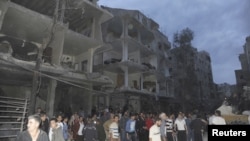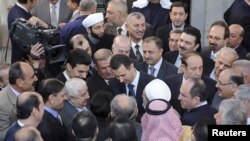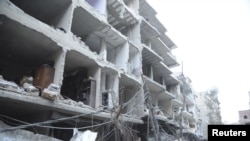A car bomb exploded near a mosque and a children's playground in Damascus Friday, killing at least five people and wounding more than 30 others. The attack shook the first day of a temporary holiday truce between government forces and rebels.
Opposition activists and Syrian news agencies report the bomb went off in the Daf Shawk neighborhood in the late afternoon.
The opposition Syrian Observatory for Human Rights says children were among those wounded when the booby-trapped car exploded.
State television blamed the bombings on "terrorists" - the government's term for the armed opposition fighting to unseat the regime of President Bashar al-Assad.
Also, the French news agency reported that 11 Syrian soldiers were wounded in a separate car-bomb attack in the southern city of Daraa.
Truce breaks down
The bombings followed an initial lull in fighting early Friday. In the flashpoint city of Homs, government forces shelled at least three districts.
Friday marked the first day of a four-day cease-fire between government forces and rebels observing the Muslim holiday of Eid al-Adha.
Witnesses reported that government forces shelled a mosque in the Damascus suburb of Harasta, which has been pounded heavily in recent days. Several people were reported to have been killed or wounded as they attended holiday prayer services.
Amateur video showed government warplanes flying over parts of Damascus and some suburbs. But residents of the northern commercial city of Aleppo told Arab satellite channels that cloudy weather prevented government planes from bombing that city.
Opposition activists said the cease-fire also broke down around a besieged government base near the strategic town of Maarat Al Numan. The base has been surrounded by rebel fighters for days.
There was no government comment.
But Rami Abd al-Rahman of the opposition Syrian Observatory for Human Rights said that clashes have been continuing in the area of the military base since daybreak. He said that government shelling has also forced families to flee one town near Homs.
Syrian state television showed Assad attending morning prayers at a Damascus mosque, surrounded by his ministers. Assad appeared to be smiling and was shown shaking hands with supporters afterwards.
The state report accused rebel forces of violating the cease-fire, but did not offer specifics. A state TV commentator said that the rebels “have no centralized leadership” and “can't agree on anything.”
Cease-fire "Tenuous" from the Start
Hilal Khashan, who teaches political science at the American University of Beirut, said the cease-fire brokered by United Nations-Arab League envoy Lakhdar Brahimi has little chance of succeeding, since it has no enforcement mechanism:
"It doesn't really matter who is violating the cease-fire," he said. "The cease-fire is tenuous, because it lacks a mechanism for implementation.
"Lakhdar Brahimi said that the two sides would observe it and regulate it and control it on their own," he said. "From the beginning, the statement was weak.”
Edward Yeranian in Cairo contributed to this report.
Opposition activists and Syrian news agencies report the bomb went off in the Daf Shawk neighborhood in the late afternoon.
The opposition Syrian Observatory for Human Rights says children were among those wounded when the booby-trapped car exploded.
State television blamed the bombings on "terrorists" - the government's term for the armed opposition fighting to unseat the regime of President Bashar al-Assad.
Also, the French news agency reported that 11 Syrian soldiers were wounded in a separate car-bomb attack in the southern city of Daraa.
Truce breaks down
The bombings followed an initial lull in fighting early Friday. In the flashpoint city of Homs, government forces shelled at least three districts.
Friday marked the first day of a four-day cease-fire between government forces and rebels observing the Muslim holiday of Eid al-Adha.
Witnesses reported that government forces shelled a mosque in the Damascus suburb of Harasta, which has been pounded heavily in recent days. Several people were reported to have been killed or wounded as they attended holiday prayer services.
Amateur video showed government warplanes flying over parts of Damascus and some suburbs. But residents of the northern commercial city of Aleppo told Arab satellite channels that cloudy weather prevented government planes from bombing that city.
Opposition activists said the cease-fire also broke down around a besieged government base near the strategic town of Maarat Al Numan. The base has been surrounded by rebel fighters for days.
There was no government comment.
But Rami Abd al-Rahman of the opposition Syrian Observatory for Human Rights said that clashes have been continuing in the area of the military base since daybreak. He said that government shelling has also forced families to flee one town near Homs.
Syrian state television showed Assad attending morning prayers at a Damascus mosque, surrounded by his ministers. Assad appeared to be smiling and was shown shaking hands with supporters afterwards.
The state report accused rebel forces of violating the cease-fire, but did not offer specifics. A state TV commentator said that the rebels “have no centralized leadership” and “can't agree on anything.”
Cease-fire "Tenuous" from the Start
Hilal Khashan, who teaches political science at the American University of Beirut, said the cease-fire brokered by United Nations-Arab League envoy Lakhdar Brahimi has little chance of succeeding, since it has no enforcement mechanism:
"It doesn't really matter who is violating the cease-fire," he said. "The cease-fire is tenuous, because it lacks a mechanism for implementation.
"Lakhdar Brahimi said that the two sides would observe it and regulate it and control it on their own," he said. "From the beginning, the statement was weak.”
Edward Yeranian in Cairo contributed to this report.











